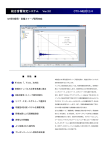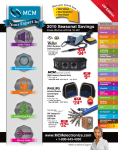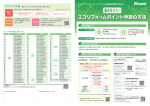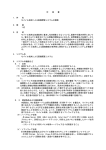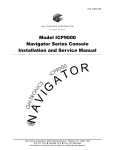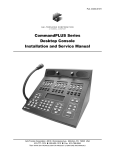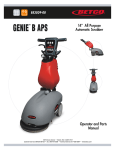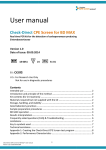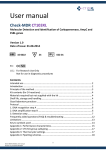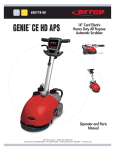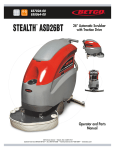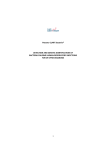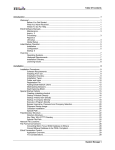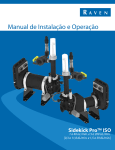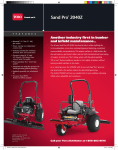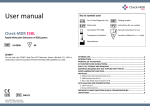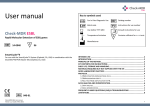Download User manual User manual - Check
Transcript
User manual Check-Direct ESBL Screen for BD MAX™ Real time PCR kit for the detection etection of ESBL-producing ESBL Enterobacteriaceae Version 1.0 Date of issue: 15.01.2015 2015 18-0066 24 066-01 EU: U.S.: For Research Use Only Not for use in diagnostic procedures Contents Intended use ………………………………………………………………………………………………………. 2 Introduction and principle of the method …………………………………………………………… 2 Kit contents (for 24 reactions) ……………………………………………………………………………. 2 Materials required but not supplied with the kit ………………………………………………… 2 Storage, handling, and stability ………………………………………………………………………….. 2 Good laboratory practices ………………………………………………………………………………….. ………………………………………………………………………………….. 3 Sample preparation procedures …………………………………………………………………………. 4 BD MAX™ operation …………………………………………………………………………………………… 4 Results Interpretation ………………………………………………………………………………………… 5 Frequently asked questions (FAQ) & Troubleshooting Troubleshooting ……………………………………….. 6 Limitations …………………………………………………………………………………………………………. …………………………………………………………………………………………………………. 7 Key to symbols used …………………………………………………………………………………………… 7 Technical assistance …………………………………………………………………………………………… 7 Appendix 1a & 1b: Creating reating the Check-Direct Check ESBL Screen test program………………8 Appendix 2: Performance Character haracteristics tics …………………………………………………………… 10 Check-Direct ESBL Screen for BD Max™ User manual Version 1.0, Issued 15-01-2015 1 Intended use Check-Direct ESBL Screen for BD MAX™ ™ is a qualitative in vitro diagnostic test for the rapid detection de in rectal swabs of Extended Spectrum β-Lactamase (ESBL) genes from Enterobacteriaceae. Check-Direct Direct ESBL Screen detects the presence of the ESBL gene families CTX-M1, CTX CTX-M2, CTX-M9 and SHV-ESBL,, presently the th primary cause of ESBL production in Enterobacteriaceae.. The assay uses the BD MAX system for extraction extraction of DNA and subsequent real-time real PCR employing the reagents provided combined with universal reagents and disposables for the th BD MAX system. Check-Direct ESBL Screen for BD MAX™ can be used as an aid to identify, prevent revent and control ESBL-producing ESBL Enterobacteriaceae that colonize patients in healthcare settings. s Check-Direct ESBL Screen for BD MAX™ is not intended to diagnose se infections with ESBL-producing ESBL Enterobacteriaceae nor to guide or monitor treatment for these infections. Parallel cultures are necessary to recover organisms for epidemiological typing, susceptibility testing and for further confirmatory identification. Introduction and principle of the method The worldwide emergence and dissemination of extended spectrum β-lactam resistance in Enterobacteriaceae is a serious threat to public health. These organisms are associated with high mortality rates and have the potential to spread widely. The most common cause of extended spectrum β-lactam resistance in Enterobacteriaceae is the production of Extended Spectrum Beta-Lactamases, Beta Lactamases, i.e. ESBL’s. Most Enterobacteriaceae producing ESBL’s have resistance to all β-lactam lactam antibiotics except carbapenems. Presently, the vast majority of clinically relevant ESBL’s are expressed from one off the following plasmid-encoded plasmid gene families: CTX-M1, CTX-M2, CTX-M9 M9 and SHV-ESBL. SHV Check-Direct ESBL Screen for BD MAX™ ™ is a multiplex real-time time PCR assay for detection of the CTX-M1, CTX CTX-M2, CTXM9 and SHV-ESBL ESBL gene families. The assay is based on specific specific recognition and amplification of target sequences by PCR, and the simultaneous detection of the accumulation of PCR amplification products by fluorescent DNA probes. The CTX-M1, CTX-M2, CTX-M9 M9 and SHV-ESBL SHV ESBL gene families have many gene variants and Check-Direct Chec ESBL has been designed to reliably detect almost all variants. Check-Direct Check ESBL for BD MAX™ employs five different fluorescent probes and enables detection and discrimination of the 4 ESBL gene families and the control target SPC, that monitors DNA extraction and PCR amplification. Kit contents (for 24 reactions) Components (Mat. No.) Descripti Description Storage conditions ESBL Screen reagent tubes (9-0131) ESBL positive control (9-0064) CP Mastermix (9-0122) User Manual (9-0134) 24 sealed tubes (orange seal) 1 tube (orange cap) 1 tube (green cap) 330 µl Leaflet – download from website + 4°C, store in the dark + 4°C + 4°C Not critical Materials required but not supplied with the kit Supplies • • • • • • Equipment BD MAX™ ExK™ DNA-1 1 Extraction Kit (Ref:442818) BD MAX™ PCR Cartridges (Ref: 437519) • Disposable laboratory (powder-free) free) gloves Pipettes & disposable (filter-)) tips for volumes of 10 and 25 µl Milli-Q water or aqua bidest • Swabs and transport media dia compatible with rectal specimen collection. Recommended swab collection device: Copan ESwab, Cat.No. 480CE or 490CE Real-time PCR instrument: BD MAX™ System, software version 2.96A or 4.3 or higher Vortex mixer Storage, handling and stability The Check-Direct ESBL Screen kit is shipped at ambient temperature and should be stored at + 4°C upon receipt. Please visually inspect the product upon initial opening to ensure that its contents are intact. Do not use this product if the packaging is damaged upon arrival and do not use reagents if their protective pouches are open or broken upon arrival. Do not use reagents if desiccant is not present present or broken inside and do not remove desiccant from protective pouches. Store all opened reagents at + 4°C until expiration date. Store in the dark. Close protective pouches promptly with the zip seal al after each use. Remove any excess ex air in the pouches prior to sealing. Please contact con the Check-Points office at [email protected] if you have any further questions. Check-Direct ESBL Screen for BD Max™ User manual Version 1.0, Issued 15-01-2015 2 Good laboratory practices Recommendations for best results The quality of the results depends on strict compliance with the following good laboratory practices, especially concerning PCR practices. • The test must be performed by adequately trained personnel. • Do not use reagents after their expiration date • Follow recommendations for storage and handling to preserve the quality of the kit’s reagents. • Protect reagents from light to avoid photo-bleaching photo of the dyes. • Periodically, verify the accuracy and precision of pipettes, as well as correct functioning and calibration of the instruments. Prevention of contaminations Use separate rooms: a sample preparation room and a PCR room with the BD MAX™ system. ystem. Never er transfer items from the PCR room to the sample preparation room. To keep laboratory free of PCR product contamination: Use pipettes with hydrophobic filter tips. Make sure to always use a new pipette tip when adding solutions, test samples, and controls to a reaction tube to avoid contamination. • Follow proper pipette-dispensing dispensing techniques to prevent aerosols. • Wear clean disposable gloves and clean lab coats for the different steps of the test. • Change gloves whenever you suspect that they are contaminated. • Keep the tubes of all kit components and samples closed as much as possible. • Clean the lab benches and all equipment regularly with a 0,5% sodium hypochlorite solution. • • Please read the full protocol before starting the test Check-Direct ESBL Screen for BD Max™ User manual Version 1.0, Issued 15-01-2015 3 Sample preparation procedures Test preparation for rectal swabs Note: The procedure for specimen collection and storage must be followed carefully using adequate specimen collection devices (see section Materials required but not supplied with the kit). kit) Rectal ectal swabs will contain varying amounts of fecal material depending on the procedure for specimen collection. Check-Points Points advices to validate your specimen collection and processing sing method with Check-Direct Check ESBL Screen prior to routine use of the test. 1. 2. 3. 4. 5. Collect rectal specimen accordingg to local guidelines and swab manufacturer recommendations. Transfer the swabs to the tubes containing liquid transport medium. Proceed with testing the samples or store according to local guidelines and swab manufacturer recommendations until further use. Vortex each tube with rectal specimen briefly and pipette 25 µl of the transport medium into one DNA Sample Buffer Tube SB-1 from the BD MAX™ ExK™ DNA-1 DNA Extraction Kit (Ref: 442818) Close the Sample Buffer Tube with a septum cap and vortex for 10 seconds. Transfer the DNA Sample Buffer Tubes to the PCR room. Preparation reparation of control reactions Quality Control requirements must be performed according to local, state and/or federal regulations regulati or accreditation requirements and your laboratory’s standard quality control procedures. Quality control procedures are intended to monitor reagent and assay performance. performance The positive control and a negative control ontrol should be run regularly until adequate process validation is achieved on the BD MAX™ System. Reduced frequency of control testing should be based on adequate data and determined by the individual laboratory. To validate the test on a regular basis, basis perform positive and negative control reactions with the Check-Direct ESBL Screen PCR run. The positive control is supplied with the kit. • Positive control: Pipette 10 µL of the positive control into one Sample Buffer Tube. Vortex for 10 seconds. • Negative control: Pipette 10 µL of Milli-Q water or aqua bidest into one Sample Buffer Tube. ube. Vortex for 10 seconds. second BD MAX™ operation 1. Multiplex real-time PCR setup Table 1 presents the multiplex real-time time PCR setup with the targets detected in each detector channel of the BD MAX™ System. Table 1: Multiplex qPCR setup Detector 475/520 530/565 585/630 630/665 680/715 Channel 1 2 3 4 5 CTX-M1 CTX-M2 SHV SHV-ESBL CTX-M9 SPC* Target *SPC: Sample Processing Control If the test is performed for the first time create the PCR test program “C-D ESBL Screen”” as described in Appendix 1. 2. BD MAX™ Rack set-up 2.1. Load the BD MAX™ system racks with the number of DNA Unitized Reagents Strips necessary for the number of samples to test. Gently tap each strip to make sure all liquids are at the bottom of their container. 2.2. Put the unitized Reagents Stripss in their positions in the BD MAX™ rack. Do not “click in” the Strips yet. 2.2.a. Snap a DNA extraction BD Exk-1 1 Reagent tube t (white seal) into position 1 of the DNA Strip, see Figure 1. 2.2.b. Snap a ESBL Screen reagent tube (orange ( seal) into position 3 of the DNA Strip, see Figure 1. 1 2.2.c. Pierce the orange seal of the ESBL SBL Screen reagent tube in position 3, e.g. with a disposable pipette tip. Next, carefully dispense 12.5µl of CP Mastermix Masterm at the bottom of the tube making sure not to create air bubbles. 2.2.d. Click the Unitized nitized Reagents Strips into their rack positions. 2.3. Place the Sample Buffer Tubes with septum caps in the BD MAX™ rack. rack Check-Direct ESBL Screen for BD Max™ User manual Version 1.0, Issued 15-01-2015 4 1 3 Figure 1: DNA Unitized Reagent Strip setup. 3. BD MAX™ instrument set-up 3.1 Open the Run tab of the BD MAX™ System software and fill in the Worklist. 3.2 Select the Test “C-D ESBL Screen”. (see Appendix 1 if not specified) 3.3 Enter the Sample Buffer Tube barcode using the barcode scanner (you can also enter the barcode manually). Start with position 1 of rack A. 3.4 Enter the specimen or patient identification information into the Accession line of the work list. Check that each specimen or patient information correspond to its specific Sample Buffer Tubes ubes in the Rack. 3.5 Load the Rack(s) into the BD MAX™ System. (Rack A is positioned on the left side of the instrument and Rack B on the right side). cartridge(s) 3.6 Load the BD MAX™ PCR cartridge(s). 3.7 Close the instrument door and select Start Run. Results Interpretation Important points before starting:: For a detailed description on how to analyze data, refer to BD MAX™ System User’s manual. Always visually inspect the amplification plot for each sample tested versus CT values obtained with the software. 1. Reported results The BD MAX™ software reports CT values and amplification curves for each detector channel of each specimen tested in the following way: • CT value of 0 indicates that there was no CT value calculated by the software with the specified Threshold (see Appendix 1) . Amplification curve of the sample showing a “0” CT value must be checked manually. • CT value of -1 indicates that no valid amplification process has occurred. Check that there is no amplification curve for the sample with a CT value of -1 1 on the graphical graphica results. • Any other CT value should be interpreted in correlation with the amplification curve and according accordi to the interpretation guidelines described below. 2. Interpretation 2.1 Run validation Verify that the real-time time PCR run is valid before data interpretation of the results. Check that there is no report of BD MAX™ System failure. If applicable, check heck the positive and negative control control amplification curves. Table 2 shows criteria for a valid Check-Direct ESBL Screen run on the BD MAX™ System. If the CT values of the controls are not as expected refer to FAQ and Troubleshooting “3”. Direct ESBL Screen test. Table 2: Criteria for a valid run with Check-Direct CT 475/520 CTX-M1 CT 530/565 CTX-M2 M2 CT 585/630 SHV-ESBL CT 630/665 CTX-M9 Positive controls 29 ±3 29 ±3 29 ±3 29 ±3 29 ±3 Negative sample -1 -1 -1 -1 29 ±3 Sample Type* Check-Direct ESBL Screen for BD Max™ User manual Version 1.0, Issued 15-01-2015 5 CT 680/715 SPC 2.2 Results interpretation If the run has been validated, interpret results as positive, negative or invalid with the CT values obtained for the samples following the guidelines summarized in Table 3. Please always check that the amplification curve of each sample is in a agreement with the CT values and results interpretation given by the software. software. Unresolved runs should be retested. Table 3: Data interpretation guidelines for rectal swabs. swabs CTX-M1 CTX-M2 SHV-ESBL CTX-M9 CT values SPC CT values Interpretation YES 29 ± 3 Positive sample -1 29 ± 3 Negative sample -1 or YES < 26 or > 32 Unresolved -1 or YES -1 Unresolved Note: • YES means that a CT valuee is observed and given in the Results R table. • CT values of rectal swabs may vary widely due to differences in fecal material and “bacterial load” of rectal swabs in transport medium. Frequently asked questions (FAQ) & Troubleshooting Refer to “the troubleshooting” section of the BD MAX™ System User’s Manual for additional information 1. Real-time results show no CT values or interpretation indicates that the sample is unresolved. unresolved Possible causes and troubleshooting: • The PCR reaction has been inhibited by exogenous or endogenous substances. Please repeat sample testing. When still inhibited a lower amount of input sample may improve the results. • The DNA extraction failed since the SPC was not detected. • The ESBL Screen reagent or CP Mastermix may have expired. • An error in liquid handling has occurred: check unitized reagent strips and PCR cartridge to determine where liquid handling problem has occurred (example: air bubble in the cartridge) and re-run re the sample. If the problem persists, contact your local BD representative. 2. Troubleshooting for unresolved results. For unresolved results: Repeat test with the original specimen by preparing a new Sample Buffer Tube. Alternatively, test newly collected specimen or use a lower amount of specimen. 3. Real-time results show no CT values for the positive control or interpretation indicating that sample is unresolved? Possible causes and troubleshooting: • The positive control solution or CP Matermix was not added. • The ESBL Screen reagent or CP Mastermix may have expired. • Air bubbles have ve occurred in the PCR chamber of the positive control. 4. Real-time time results show very low fluorescent signals in all samples and detector channels including the SPC signal. Possible causes and troubleshooting: • The ESBL Screen reagent tubes containing the fluorescent probes and primers may be degraded. Please check expiration n date and make sure that the ESBL Screen tubes have been stored correctly. • The BD MAX™ System can be responsible for these results. Please refer to BD MAX™ User’s manual or contact your BD local representative. 5. The BD MAX™ System states an error or failure. Refer to the BD MAX™ instrument user manual or contact your BD local representative. re 6. Duplicate samples ples tested with Check-Direct Check ESBL Screen assay do not yield identical results. CT values of identical samples may vary between individual reactions. Large variations, > 2 CT values, suggest pipetting errors or other differences between the duplicate samples. Check-Direct ESBL Screen for BD Max™ User manual Version 1.0, Issued 15-01-2015 6 Limitations Check-Direct Direct ESBL uses a range of specific DNA markers to detect the presence of the CTXCTX-M1, CTX-M2, CTX-M9 and SHV-ESBL ESBL genes, which currently represent the clinically most prevalent ESBL’s. The test detects almost all clinically relevant variants of CTX-M1, CTX-M2, M2, CTX-M9 CTX and SHV-ESBL. It should be noted that some more rare variants of CTXM1, CTX-M2, CTX-M9 and SHV-ESBL are not detected and that other ESBL gene families like e.g. TEM, GES, VEB and PER are also not detected. The test is only intended to be b used with rectal swabs in transport medium as input material. The quality of the input DNA is an important factor for obtaining reliable reliable results with Check-Direct Check ESBL Screen for BD MAX™. DNA must be extracted from rectal swabs using the devices and procedures described escribed in this manual. manual The assay has been tested extensively with DNA purified from gram-negative negative bacteria, such as Escherichia, Salmonella, Klebsiella, Enterobacter, Citrobacter and Pseudomonas, with excellent results. However, it may never be excluded that other Gram-negative negative bacteria or certain strains of the above species will yield yield poor results. Check-Direct Check ESBL Screen cannot and does not make any representation or warranty that it is capable of correctly c ctly detecting the ESBL genes in all gram-negative negative species, subspecies or types type or in all clinical samples.. Results may need to be confirmed by additional methodologies in specific cases (e.g. for regulatory samples). Due to the high variability of bacterial bac genomes it is possible that certain subtypes might not be detected. The test reflects the state of knowledge of Check-Points Check Health B.V. The presence of multiple bacterial species in a sample may hamper the interpretation of the test. As with other diagnostic assays, the results of this test may only be interpreted in combination with additional laboratory and clinical data available to the responsible person. Use of this assay is limited to appropriately qualified personnel, wellwell trained in performing DNA-based based molecular detection methods. Key to symbols used Symbol CP Mastermix Definition CP MasterMix ESBL control For In Vitro Diagnostic Use Catalog number Batch code IFU number Use before YYYY-MM Consult instructions for use Manufacturer Temperature limitation Contains sufficient for < n > tests Technical assistance [email protected] +31 317 453 908 Despite the utmost care in the development and preparation of the protocol Check-Points Check cannot take any responsibility for errors, omissions and/or future changes herein. Literature Citation:: When describing a procedure for publication using this product, please refer to it as the Check-Direct Direct ESBL Screen. Notice to Purchaser: This product is sold under license from PHRI Properties and may be used under PHRI Properties patent rights only for human in vitro diagnostics, food testing, veterinary testing, or research. Dye & quencher compounds in this product are sold under license from Biosearch Technologies, Inc. and protected by U.S. and world-wide wide patents either issued or in application. The license grant covers human in vitro diagnostic (IVD) applications Trademarks BD, BD MAX™ are trademarks Becton Dickinson GmbH Check-Points Health BV Binnenhaven 5 6709 PD Wageningen The Netherlands Tel: +31 317 453 908 Fax: +31 317 210 147 [email protected] points.com www.check-points.com points.com 7 Check-Direct ESBL Screen for BD Max™ User manual Version 1.0, Issued 15-01-2015 Appendix 1a:: Creating the Check-Direct Check ESBL Screen test program (v2.96A and up) Important points before starting: Refer to BD MAX System User’s Manual for detailed instructions on how to operate the BD MAX System and software version 2.96A or higher. test and enter the following parameters: 1. Create a new Test, select Create test, • Test Name: type C-D ESBL Screen. • Extraction Type: Select Exk DNA-1 1 (Plasma/Serum). • Master Mix Format: choose Type 3: Liquid MM with Primers and Probes. • Channel detector Settings: set Gain and Threshold with parameters specified pecified in Table A. • GardRail:: select “User” and enter values specified in Table B. Only the “Sample Volume” differs from the default settings. • Test details:: enter the PCR profile as outlined in Table C. • Spectral Cross Talk tab:: enter parameters specified in Table D. 2. Select Save Test. Table A: Gain parameters. Detector Alias Gain Threshold 475/520 530/565 585/630 630/665 680/715 CTX-M1 group CTX-M2 group SHV-ESBL CTX-M9 group SPC 80 80 30 80 40 100 100 100 100 100 Table B: GardRail parameters. Parameters Value Lysis Heat Time Lysis Temperature Sample Tip Height Sample Volume Wash Volume Neutralization Volume DNase Heat Time 10 37 1600 600 500 ------- Table C: Real-time protocol parameters. Step Name Profile Type Denaturation Hold Cycles 1 Amplification &Detection 2 - temperature 50 Time (s) Temp(°C) 98 NO 15 98 NO 62 60 YES Table D: Spectral cross-talk parameters. 475/520 530/565 Excitation 585/630 Channel 630/665 680/715 False Receiving Channel 475/520 530/565 585/630 630/665 680/715 1.6 0.0 0.0 0.0 1.2 1.2 0.0 0.0 0.0 0.0 10.7 0.0 0.0 0.0 6.3 5.6 0.0 0.0 0.0 7.8 8 Check-Direct ESBL Screen for BD Max™ User manual Version 1.0, Issued 15-01-2015 Detect 600 Appendix 1b: Creating the Check-Direct Check Direct ESBL Screen test program (v 4.30B and up) Important points before starting: Refer to BD MAX™ System User’s Manual for detailed instructions on how to operate the BD MAX™ System ystem and software version 4.30B or higher. To create a new Test, in the Test Editor tab, select Create, and apply the following instructions: 1. In the Basic Information tab enter the following parameters: • Test Name: C-D ESBL Screen. • Extraction Type: Select Exk DNA-1 1 (Plasma/Serum). • Master Mix Format: select Type 3: Liquid MM with Primers and Probes. • Sample Extraction Parameters: select User defined and adjust sample volume to 600µl, see Table A. • Ct Calculation: select Call Ct at inflection point Save parameters 2. In the Channel Settings tab: B • Alias, PCR Gain, and Threshold: for each channel detector enter the correct parameters specified in Table B. • Color compensation:: enter the correct parameters specified in Table C Save parameters 3. In the Test Steps tab: enter the PCR steps as specified in Table D. Save parameters Table A: Sample Extraction Parameters. Parameters Value Lysis Heat Time Lysis Temperature Sample Tip Height Sample Volume Wash Volume Neutralization Volume 10 37 1600 600 500 ---- DNase Heat Time ---- Table B: Alias, PCR Gain,Threshold parameters. Detector Alias Gain Threshold 475/520 530/565 585/630 630/665 680/715 CTX-M1 group CTX-M2 group SHV-ESBL CTX-M9 group SPC 80 80 30 80 40 100 100 100 100 100 Table C: Spectral cross-talk parameters. 475/520 530/565 Excitation 585/630 Channel 630/665 680/715 False Receiving Channel 475/520 530/565 585/630 630/665 680/715 1.6 0.0 0.0 0.0 1.2 1.2 0.0 0.0 0.0 0.0 10.7 0.0 0.0 0.0 6.3 5.6 0.0 0.0 0.0 7.8 Table D: Test PCR Steps parameters. Step Name Profile Type Cycles Denaturation Hold 1 Amplification &Detection 2 - temperature 50 Time (s) 600 Temp(°C) 98 NO 15 98 NO 62 60 YES 9 Check-Direct ESBL Screen for BD Max™ User manual Version 1.0, Issued 15-01-2015 Detect Appendix 2: Performance Characteristics 1. Limit of Detection with Rectal Swabs The analytical limit of detection (LoD)) of Check-Direct Check Direct ESBL Screen for BD MAX™ was determined with ESBL-producing bacteria spiked into ESBL-negative negative natural human pooled rectal swabs matrix. The LoD was determined for each gene analyte, i.e., the genes encoding CTX-M1 M1 group, CTX-M2 group, CTX-M9 group, and SHV-ESBL ESBL. ESwab Amies transport medium (Copan) was “sampled” with approximately 10 mg/ml of human feces. Strains containing the target ESBL genes were grown o/n and a minimum of 5 different concentrations of cell suspensions were prepared in Milli-Q water starting from a suspension with a density of 0.5 McFarland. Bacteria were counted by plating on non-selective non media and diluted into the rectal swab matrix to create specimens with a well-defined well defined amount of fecal material and target bacteria. Specimens created as described above were used to assess the analytical limit of detection (LoD) following the protocol described on pages 4 and 5 of this User Manual. Results are depicted in the Table below. SBT refers to the BD MAX™ Sample Buffer Tube. ESBL group CTX-M1 group CTX-M1 group CTX-M2 group CTX-M2 group CTX-M9 group CTX-M9 group SHV-ESBL SHV-ESBL SHV-ESBL; CTX-M9 group Organism Name Enterobacter cloacae Klebsiella pneumoniae Escherichia coli Escherichia coli Escherichia coli Enterobacter cloacae Escherichia coli Klebsiella pneumoniae Escherichia coli Strain ID CP0159 CP0160 CP0187 CP0086 CP0158 CP0028 CP0232 CP0128 CP0456 CFU/SBT 2 11 5 50 5 45 30 53 24 2. In silico Specificity The specificity of the Check-Direct Direct ESBL Screen real-time real time diagnostic test is ensured by the selection of the correct primers and probes, as well as the selection of stringent reaction conditions. Primers and Probes sequences were designed to specifically identify dentify the gene variants listed in the Table below. A 100% sequence match with the primers and probes by in silico analysis was assumed to warrant reliable detection of each of the depicted variants. Single mismatches with the primers and probes exist in some variants, of which we expected that detection would not be compromised. This was confirmed by testing such variants in comparison with variants which were 100% homologous. Primers and Probes sequences were tested for potential homologies with genes from from other organisms using all gene st sequences present in the international gene bank on April 1 , 2014. (GenBank®, NIH genetic sequence database). using sequence comparison analysis. No cross homology was found with other organisms for the selected primers and probes. ESBL gene Variants detected CTX-M1 group 1,3,10-12,15,22,23,28 12,15,22,23,28-30, 32-34,36,37,42,52-55,57,58,60-62,66,68,69,71,72,79,80,82,88,96,103,107, 79,80,82,88,96,103,107,109,114,116, 117,133,139,142 CTX-M2 group 2,4-7,20,31,35,43,44,56,59,76,77,92 7,20,31,35,43,44,56,59,76,77,92,97,124,131 CTX-M9 group 9,13,14,16-19,21,24,27,38,45 ,27,38,45-51,55,57,64,65,67,81,83-86,90,98.102,104,105,106,110-113,121 113,121-123,126,134,147 SHV-ESBL 2,5,12,15,39,45,46,48,56,64,66,71 ,12,15,39,45,46,48,56,64,66,71 3. Analytical Inclusivity The analytical inclusivity of the Check-Direct Direct ESBL Screen real-time real time diagnostic test was evaluated by testing a panel of 17 bacterial strains, 5 for CTX-M1 1 group, 3 for CTX-M2 CTX group, 5 for CTX-M9 9 group and 7 for SHV-ESBL. SHV See Table below. A similar protocol as for the LoD study stud was used (see above section 1). ). Bacteria were tested in duplicates or triplicates in pooled negative rectal swab matrix near the analytical limit of detection (LoD) and concentration were confirmed by plating bacterial cell suspension on non-selective non media in n duplicates. The 17 1 bacterial strains used in this retrospective study were previously well characterized with the Check-Points Check Points microarray diagnostics test CheckCheck MDR CT103 (Check-Points Health). Under the conditions of this study, all 17 bacterial strains were detected with the Check-Direct Direct ESBL Screen for BD MAX™ assay. assay. Inclusivity was 100%. Results are depicted in the Table below. 10 Check-Direct ESBL Screen for BD Max™ User manual Version 1.0, Issued 15-01-2015 Organism Name Strain ID Multidrug resistant genotype (Check MDR CT103) TEM SHV WT* CTX-M group Carba* CFU/SBT* AmpC Escherichia coli CP0255 Klebsiella pneumoniae CP0160 Enterobacter cloacae CP0159 WT 1-15 Escherichia coli CP0060 WT 1-1 27 Escherichia coli CP0085 WT+104K+238S 1-32 41 Klebsiella pneumoniae CP0189 2 19 Escherichia coli CP0087 WT 2 117 Escherichia coli CP0086 WT 2 91 Enterobacter cloacae CP0028 Escherichia coli CP0158 WT Escherichia coli CP0152 WT WT+238S+240K IMP-8 9 Klebsiella pneumoniae CP0232 WT WT+238S/240K KPC-2 47 Klebsiella pneumoniae CP0149 238S IMP-1 Escherichia coli CP0128 Enterobacter cloacae CP0066 Escherichia coli CP0456 Escherichia coli CP0308 WT 1-3 4 1-3 30 OXA-48 2 9 9 WT 238S 238S+240K WT 45 OXA-48 5 52 ACC 9 238S+240K 9 WT+238S/240K 9 53 74 24 VIM-1 58 *SBT: sample buffer tube (BD); Carba: carbapenemase gene; gene WT = wild type = non-ESBL TEM or SHV 4. Analytical Exclusivity The analytical exclusivity of the Check-Direct Check ESBL Screen real-time time diagnostic test was determined by testing the cross-reactivity ctivity with samples containing a high amount of non-target organisms. 73 ESBL-negative negative strains were used to test the specificity of the Check-Direct Direct ESBL Screen real-time test, that were previously well characterized with the Check-Points Points microarray diagnostics test Check-MDR Check CT103 (Check-Points Points Health). An overview of these strains is outlined in the Table below. Strains were tested in replicates at concentrations concentra ≥ 10⁶⁶ CFU/ml. Bacteria were spiked into pooled negative rectal swab matrix. All isolates tested negative with the Check-Direct Check Direct ESBL Screen for BD MAX™ and the internal control was reliably detected in all samples. The analytical exclusivity ty was 100% for the specified strains tested. Organism Strain ID Related β-lactamase present Acinetobacter baumannii CP0281 TEM-wt Acinetobacter baumannii CP0284 --- Acinetobacter baumannii CP0327 PER Acinetobacter baumannii CP0439 OXA-58 Acinetobacter baumannii CP0441 OXA-23+ -58 Acinetobacter baumannii CP0444 OXA-23 Acinetobacter baumannii CP0445 OXA-23; TEM-wt Aeromonas caviae CP0374 VIM VIM-4 Aeromonas genomospecies CP0169 Citrobacter braakii CP0338 GES; CMY-2 Citrobacter braakii CP0375 VIM Citrobacter freundii CP0035 --- Citrobacter freundii CP0288 --- Citrobacter freundii CP0337 GES; ACT Enterobacter aerogenes CP0398 OXA-48 Enterobacter cloacae CP0006 ACT Enterobacter cloacae CP0068 ACT Enterobacter cloacae CP0161 VIM-1; ACC Enterobacter cloacae CP0236 KPC; TEM-wt Enterobacter cloacae CP0272 TEM-wt Enterobacter cloacae CP0339 GES; ACT Enterobacter cloacae CP0371 GIM; ACT TEM-wt and SHV-wt refer to wild type = non-ESBL ESBL TEM & SHV 11 Check-Direct ESBL Screen for BD Max™ User manual Version 1.0, Issued 15-01-2015 Organism Strain ID Related β-lactamase present Escherichia coli CP0016 TEM-wt Escherichia coli CP0021 CMY-2 Escherichia coli CP0027 GES Escherichia coli CP0095 IMP Escherichia coli CP0096 KPC Escherichia coli CP0097 OXA-48 Escherichia coli CP0139 ACC; TEM-wt Escherichia coli CP0131 FOX; TEM-wt Escherichia coli CP0134 DHA Escherichia coli CP0136 ACT; TEM-wt Escherichia coli CP0196 KPC; TEM-wt; SHV-wt Escherichia coli CP0228 Escherichia coli CP0457 NDM-1; CMY-2 --- Klebsiella oxytoca CP0352 GES Klebsiella oxytoca CP0402 OXA-48 Klebsiella pneumoniae CP0056 SHV-wt Klebsiella pneumoniae CP0101 SHV-wt; DHA Klebsiella pneumoniae CP0104 SHV-wt; TEM-wt+164S; DHA) Klebsiella pneumoniae CP0107 SHV-wt; DHA Klebsiella pneumoniae CP0108 SHV-wt; DHA Klebsiella pneumoniae CP0135 SHV-wt; TEM-wt; DHA Klebsiella pneumoniae CP0141 SHV-wt; TEM-wt+164S; ACT Klebsiella pneumoniae CP0142 SHV-wt; TEM-wt+164S; ACT Klebsiella pneumoniae CP0143 CMY-2; SHV-wt Klebsiella pneumoniae CP0233 KPC; TEM-wt; SHV-wt Klebsiella pneumoniae CP0243 VIM; SHV-wt Klebsiella pneumoniae CP0314 SHV-wt Klebsiella pneumoniae CP0316 SHV-wt Klebsiella pneumoniae CP0342 GES; SHV-wt Klebsiella pneumoniae CP0349 GES; SHV-wt Klebsiella pneumoniae CP0363 OXA-48; SHV-wt Klebsiella pneumoniae CP0365 KPC; SHV-wt Klebsiella pneumoniae CP0379 VIM; SHV-wt Klebsiella pneumoniae CP0392 KPC; TEM-wt; SHV-wt Klebsiella pneumoniae CP0393 KPC; TEM-WT; SHV-WT Klebsiella pneumoniae CP0418 OXA-48; TEM-WT; SHV-WT Proteus mirabilis CP0015 CMY-2; TEM-wt Proteus mirabilis CP0068 CMY-2; TEM-wt Proteus mirabilis CP0317 VEB; TEM-wt Providencia stuartii CP0319 VEB; TEM-wt Providencia rettgeri CP0358 VEB; NDM Pseudomonas aeruginosa CP0245 VIM Pseudomonas aeruginosa CP0246 VIM Pseudomonas aeruginosa CP0336 BEL; VIM Pseudomonas aeruginosa CP0352 PER; VIM Pseudomonas aeruginosa CP0358 VEB Salmonella barreilly CP0125 ACC Salmonella barreilly CP0127 ACC Salmonella heidelberg CP0133 CMY-2 Salmonella heidelberg CP0139 Stenotrophomonas maltophilia CP0062 CMY-2 --- TEM-wt and SHV-wt refer to wild type = non-ESBL ESBL TEM & SHV 12 Check-Direct ESBL Screen for BD Max™ User manual Version 1.0, Issued 15-01-2015












